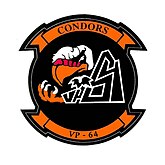| Fleet Logistics Support Squadron 64 | |
|---|---|

C-130T Hercules of the squadron at
Stuttgart Airport | |
| Active | 1 November 1970 – present
[1] (53 years, 5 months) |
| Country | |
| Branch | |
| Type | Squadron |
| Role | Logistics |
| Part of | United States Navy Reserve |
| Garrison/HQ | Fort Dix, New Jersey |
| Nickname(s) | Condors, Flying Chicken |
| Insignia | |
| Fleet Logistics Support Squadron 64 emblem |
 |
| Patrol Squadron 64 emblem |
 |
| Aircraft flown | |
| Transport | C-130T |
Fleet Logistics Support Squadron 64 (VR-64), nicknamed the Condors, is a logistics squadron of the U.S. Navy Reserve, based at the Fort Dix entity of Joint Base McGuire–Dix–Lakehurst. The squadron was established as Patrol Squadron 64 (VP-64) on 1 November 1970 and redesignated on 18 September 2004, after 34 years of service. It was based at NAS Willow Grove, Pennsylvania until it was transferred to the Fort Dix element of Joint Base McGuire–Dix–Lakehurst in 2011. [2] Units of the squadron made 26 major overseas deployments. [3] [4]
Operational history

- 1 Nov 1970: VP-64 was established as a reserve patrol squadron at NAS Willow Grove, under the operational control of Reserve Patrol Wings, Atlantic. VP-64 was established from previously existing reserve VPs—66W1-W3, 21W4, 26W5 and 23W6—as a result of a major reorganization of the Naval Air Reserve that took place in 1970. The 12 reserve squadrons formed were structured along the lines of regular Navy squadrons with nearly identical organization and manning levels. The concept, known as the 12/2/1 had 12 VP squadrons under two commands, Commander Fleet Air Reserve Wings Atlantic and Commander Fleet Air Reserve Wings Pacific, both under the control of one central authority, Commander Naval Air Reserve. VP-64 was initially equipped with 12 Lockheed SP-2H Neptune aircraft, 60 officers and 323 enlisted personnel.
- June 1973–June 1974: The squadron's first Lockheed P-3A DIFAR Orion arrived. Transition training for aircrews was completed in June 1974.
- 7 February 1977: VP-64 participated in Anti-submarine warfare (ASW) operations with CTG 84.3 in the Mediterranean for a period of three days. The squadron was awarded a Meritorious Unit Commendation on 1 December 1977 for its performance.
- October 1982–October 1983: Crew transition training to the P-3A TAC/NAV MOD airframe was begun and completed in October 1983. The TAC/NAV MOD version replaced the ASN-42 navigation and tactical display systems with the LTN-72 inertial and Omega navigation systems and digital computer.
- January 1987: Perimeter security at NAS Willow Grove was breached by a peace activist group. Several members of the group were able to damage one of the squadron's aircraft before base security was able to respond.
- 1990: VP-64 traded in their 10 P-3A Orions for eight P-3B TAC/NAV MOD aircraft. The IRDS/HACLS modifications added infrared detection. The completion of these modifications gave squadron aircraft a Harpoon launch capability. The Harpoon missile capability was originally intended specifically for the elimination of Soviet surveillance trawlers in the event of war.
- April–May 1993: VP-64 deployed to Nimes, France, in support of joint French-American ASW exercises. A detachment was maintained at RNAS Souda Bay, Crete. Several crews were put on alert status at Naval Air Station Sigonella, Sicily, during the period of heightened tensions in the former Yugoslavian Republic in support of UN sanctions.
- January–March 1994: VP-64 deployed several detachments to Roosevelt Roads Naval Station, Puerto Rico, in support of Operation Uphold Democracy. The detachments assisted in supporting UN sanctions against Haiti.
- April 1994: VP-64 began the transition from the P-3B to the P-3C UII. It incorporated the latest in avionics and weapons systems, including a turret-mounted infrared detection device to drop out of the nose to identify targets day or night.
- July–September 1995: VP-64 deployed several detachments to Roosevelt Roads Naval Station, in support of DoD counter-narcotics patrols in the Caribbean theater. During this period the Condors assisted in the tracking and seizure of narcotics shipments estimated at a street value of $2.5 billion. [3]
Aircraft assignment
The squadron first received the following aircraft on the dates shown: [3]
- SP-2H Neptune – November 1970
- P-3A DIFAR Orion – June 1973
- P-3A TAC/NAV MOD Orion – June 1982
- P-3B TAC/NAV MOD Orion – 1990
- P-3C UII Orion – April 1994
See also
- Maritime patrol aircraft
- List of Lockheed P-3 Orion variants
- List of inactive United States Navy aircraft squadrons
- List of United States Navy aircraft squadrons
- List of squadrons in the Dictionary of American Naval Aviation Squadrons
- History of the United States Navy
References
This article incorporates text from the public domain Dictionary of American Naval Aviation Squadrons.
- ^ Office of the Chief of Naval Operations (11 April 2012). OPNAV INSTRUCTION 5030.4G (PDF). Washington, D.C.: Department of the Navy. p. 19. Archived (PDF) from the original on 9 July 2022. Retrieved 2 August 2022.
- ^ Sloan, Dennis L. (24 March 2011). "All hands on deck: VR-64 arrives at JB MDL". Joint Base McGuire-Dix-Lakehurst. Retrieved 22 March 2022.
- ^ a b c Roberts, Michael D. (2000). Dictionary of American Naval Aviation Squadrons, Volume 2, Chapter 3, Section 11: Patrol Squadron Histories for 2nd VP-62 to VP-90 (PDF). Washington, D.C.: Naval Historical Center, Department of the Navy. pp. 329–331. Retrieved 1 September 2023.
- ^ Leland, Wendy (1 January 2005). "Airscoop: VP-64 becomes VR-64" (PDF). Naval Aviation News: 7. Retrieved 1 September 2023.
External links
